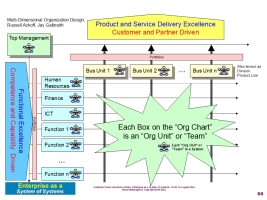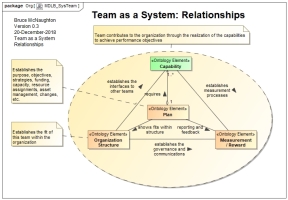Name: : Team
Based on: Organization
The Team is a fundamental building block within an organization. The purpose of the team is to deliver the capabilities that are needed to contribute to and support the overall performance of the enterprise.
In addition, a team is also capable of creating, managing, improving and releasing other teams within their Organization. This provides for the dynamic evolution and adaptation of the enterprise.
Teams can also form part of a temporary Organization to support change or transformation. Teams also form part of the governance arrangements of an enterprise (e.g. Board of Directors).
Systemic Measurable Variables
The Team is measured on the variables needed to demonstrate performance and contribution. These relate to the following:
- The specific objectives identified for the team. (Each objective delivers a result which can be measured).
- The specific objectives for each team capability and process. (Each process has its own objectives and variables)
- The culture arising within the team and it's alignment to the overall Enterprise. (desired or undesired).
- The speed of change and adaptability.
- The investment in improvements and the resulting improved performance.
Systemic Capabilities or Functions
Teams deliver a mix of team capabilities. The Management Capabilities exist in all teams from the time they are created. The following represents the various types of capabilities delivered by a Team:
There are a number of types of capabilities that are used by a team:
- Management capabilities: Always present for every team along with a manager
- Core Delivery capabilities: Those capabilities with a direct relationship to the purpose of the overall organization.
- Support capabilities: Those that support the organization and other teams achieve their contribution.
- Local capabilities: Those capabilities that are unique to one or more teams and are necessary to achieve the organizations objectives.
See Capabilities for a typical list of capabilities within each of the types.
System States
A Team can be in the following states:
- Architectural states
- Identified: The name of the team is identified
- Defined: The team description is complete. The definition is independent of the realization.
- Transformational States
- Manager Appointed: A manager has been appointed.
- Planned: A team plan has been approved.
- Operational States
- Active: A team is now active and working to meet objectives.
- Note: Assessments and audits will generally be against the approved plan. This will lead to improvements in performance within the scope of the approved plan.
- Closing: The manager is releasing team members and closing down the team.
- Closed: The team is closed and removed from plans.
- Active: A team is now active and working to meet objectives.
Team Manager
- Are the plans identifying what we need to be successful?
- Does our plan include purposeful actions to improve our performance?
- Can we achieve our objectives?
- Do our plans align with the objectives, and performance of the Organization.
- Do our plans deliver the right capabilities with the necessary capacity?
- Do we integrate and collaborate with other teams?
Team Members
- Do I understand the purpose and objectives of our team?
- Do I have the skills, knowledge and experience to contribute to this team?
- Do I have a development plan to enhance my skills, knowledge and experience and improve my performance?
- Are my objectives aligned to the success of the team?
- Do I understand the capabilities needed for this team?
A team is an integral part of an Organization. The positioning of the team is shown in the following picture:
A team works within a structure of other teams within the Organization and may work with teams or organizations outside of the environment of the Organization.. This is a key integration or collaboration role of the team.
The team purpose must fit within the Organization as a whole and contribute to the overall purpose of the organization.
The Team must fit within the context of the organizational structure identified for the team. This typically is shown within an organization chart where each box on the organization chart is a team.
The Top Management Team establishes the boundary of the Organization.
System Element: Identification
The system elements of a team are shown in the following picture:
The team elements are the same as the Organization elements. The team represents a single team within the organizational structure. The team model is a fractal model at all levels within the Organization.
A team delivers their intended contribution and results through the interaction of the following items:
- Each Capability is delivered through the interaction of
- People (at least one)
- Process (Activities and Decisions)
- Technology Item (Tools and Facilities)
- Measurement and Rewards
- Structure (Fit within the organizational structure)
- A Team (Management) Plan to deliver intended results
The organizational structure provides the context and environment of the specific team within the Organization.
System Element: Relationships
The relationships between the system elements are shown in the picture below:
The primary relationships of the team are through the contribution to the realized capabilities of the team. These may require the team to work across the Organization to deliver its value. These relationships are built into each of the processes that are part of the capabilities delivered (created, managed, used, improved and released) by the team.
Each Capability is realized through the interaction of people, process and technology. Each interaction is described below:
- People <--> Process: A person takes on a role and associated responsibilities to carry out an activity.
- Process <--> Technology: A Technology Interaction Point identifies where technology automates the process.
- People <--> Technology: The technology improves the effectiveness and efficiency of the person. The appropriate human factors have been considered.
The structure interacts with all of the other elements and provides a context for the contribution of the team:
- Structure <-> Process: The horizontal view of the organization is expressed through the activities within a process and the associated roles. Multiple teams may contribute to the desired results of a process.
- Structure <-> People: The structure provides the accountability of the managers and their team within the overall Integrated Management System
- Structure <-> Technology: The technology improves the effectiveness and efficiency of the person. The appropriate human factors have been considered.
- Structure <-> Plans: The structure provides a planning structure to ensure that all plans are aligned across the organization.
- Structure <-> Measurement / Rewards: The alignment of measurements / rewards within the structure ensures there is performance can be monitored and rewards allocated in a holistic way to benefit the whole organization and the customers.
The plans system element ensures that there are sufficient people, process and technology to achieve the objectives set in the plan. These plans also enable a baseline for performance management (measurement and rewards). The Measurement and Rewards element allows the tracking and usage of all of ther other elements in the context of the overall team performance.
An alternative picture of the team system element interactions is shown below:
This picture is an adaptation of the STAR Model identified by Jay Galbraith in his 1977 book, Organization Design. This model is a fractal model that applies to an individual team or the whole organization.
Configuration / Scenario:
Describes any configuration / scenario attributes for a specific system-of-interest. This may not be appropriate for all system descriptions (e.g. patterns or abstract systems).
Development Life Cycle Processes
A team is created, operated or released by another team using the Team Performance Management using the organizing Activities of a Manager. The new team is added or removed from the organizational structure of the Organization.
Cyclical (Repeating / Regular) Processes
The design of the team is created through an Organization Design capability. This capability identifies the organizational structure and the fit within the organization. The positioning of the team may be identified through the replication of a team based in one location to one or more locations. The team may also be designed to handle a specific type of work (e.g. product development or product type). Delivery teams are designed based upon their fit within an operational process to deliver products and services to customers. The realization of a team is started when a manager has been appointed. The manager will then create the team. to deliver the capabilities allocated to the team.
The following references support this type of system-of-interest.



